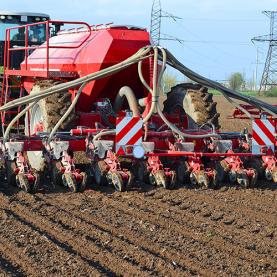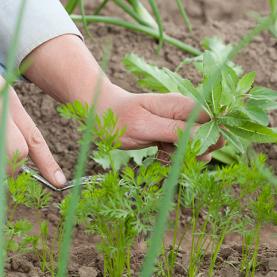Potato
Potatoes are native to the Andes and are the most widely used tubers in the food industry today. Grown by the Incas in the 13th century, they were brought to Europe by the Spanish in the 16th century, where they were used as an ornamental plant. Potatoes were first served on our plates in the 18th century, as an alternative food source in times of war.
Foodstuff or ornament? Introduction to Europe
In the 13th century in the Andes, the Incas began cultivating potatoes as the basis of their diet. The Spanish conquistadors introduced them into Europe three centuries later. For some two hundred years following the introduction of potatoes into the old continent, a lack of knowledge of how to grow and cook them meant they were rarely consumed. The potato plant was used for ornamental purposes in the gardens of the wealthy, or as food for the poor and for animals. Since the tuber is a member of the Solanaceae family, which includes poisonous plants (such as deadly nightshade, datura and the ‘magical’ mandrake) that cause hallucinations and death if ingested in high doses, potatoes were not widely consumed. While Catholics in Ireland blessed potatoes before planting them on Good Friday, Protestants from Anglo-Saxon countries found no mention of them in the Bible and therefore refused to use them.
Potatoes nonetheless became popular in Europe during the 18th century, after they were used as a cheap alternative food source to stave off famine during the Seven Years’ War (1756-1763). They are now the most widely used tubers in the food industry and the largest non-cereal food crop in the world.
A climate-resilient crop
Potatoes are mainly grown in fields. Whether cultivated intensively or extensively, potatoes adapt to all climates, from the high Peruvian plateau to the Indus-Ganga plain. After the ground has been prepared and fertilised, seed potatoes (whole or cut tubers) are buried beneath the soil. To reduce problems of contamination, potatoes are planted at a distance from other crops prone to similar diseases. During the formation of the flowers and tubers, the potato plant is very sensitive to prolonged periods of drought or rain. To ensure even maturation of the tubers and eliminate the risks of parasites and disease (such as blight), a few weeks before harvest, the plants undergo mechanical or thermal stripping to destroy the foliage and stems, called ‘haulms’.
A varied tuber
Potatoes are rich in nutrients, such as carbohydrates, vitamins and minerals. The plant can reach a height of around one metre. Its leaves have fine hairs and its flowers are white, pink or purple, with a hint of yellow. The plant also produces fruit in the form of small green berries which are poisonous to humans, but whose seeds enable the plant to reproduce. The edible part is the tuber, the extremity of a rhizome growing beneath the soil and acting as a food reserve for the plant. Potatoes have been grown on all continents and appreciated for centuries. They come in thousands of varieties with different characteristics, methods of cultivation, and culinary uses. The vitelotte variety, grown since the early 19th century, stands out for its purple skin and flesh, due to high levels of anthocyanin. Vitelotte potatoes retain their colour even when cooked, and can therefore be used to create unusually coloured soups, purées, crisps or chips. Alexandre Dumas, the author of Les Trois Mousquetaires (The Three Musketeers) wrote in his Grand Dictionnaire de Cuisine in 1873, “...the best of all are unquestionably the violet ones, preferable even to the red ones, and known in Paris by the name of Vitelottes (sic).”
Potato shortage and famine
Potato blight ravaged crops in Ireland, causing one of the biggest famines of the 19th century. Between 1845 and 1852, almost two million people died, the equivalent of one quarter of the Irish population, and one million emigrated to the United States to flee the famine.
CLERC, Maurice, s.d. Le défanage thermique des pommes de terre. Institut de recherche de l'agriculture biologique [en ligne]. [Consulté le 15 mai 2016]. Disponible à l’adresse : www.http://www.bioactualites.ch/fr/sol-sain-plantes-saines/grandes-cultures-bio/pommes-de-terre/defanage-thermique.html
DUMAS, Alexandre, 1873. Grand Dictionnaire de Cuisine, Paris : Alphonse Lemerre.
FAO | Organisation des Nations Unies pour l’alimentation et l’agriculture, 2008. La pomme de terre. In : FAO, 2008. Année internationale de la pomme de terre [en ligne]. [Consulté le 20 juillet 2015]. Disponible à l’adresse : ftp://ftp.fao.org/docrep/fao/011/i0500f/i0500f02.pdf
NIVAA HOLLAND, 2002. Les processus de transformation de la pomme de terre. Pays-Bas : NIVAA Institut consultatif néerlandais pour les Pommes de Terre.
ROUSSELLE, Patrick, ROBERT, Yvon, CROSNIER, Jean Claude, 1996. La pomme de terre : production, amélioration, ennemis et maladies, utilisations. Institut national de la recherche agronomique. Paris : Éditions Quae. ISBN 9782738006769
TABARLY, Sylviane, 2009. La France : des territoires en mutations. Du champ à l’usine, production et transformation d’une denrée agricole : la pomme de terre et le « système » McCain. Géo confluences [en ligne]. 15 décembre 2009. [Consulté le 17 juillet 2015]. Disponible à l’adresse : http://geoconfluences.ens-lyon.fr/doc/territ/FranceMut/FranceMutDoc15.htm
ZUCKERMAN, Larry, 1999. The Potato, From the Andes in the Sixteenth Century to Fish and Chips, the Story of How a Vegetable Changed History. Londres: Macmillan Publishers. ISBN 9780333750643












